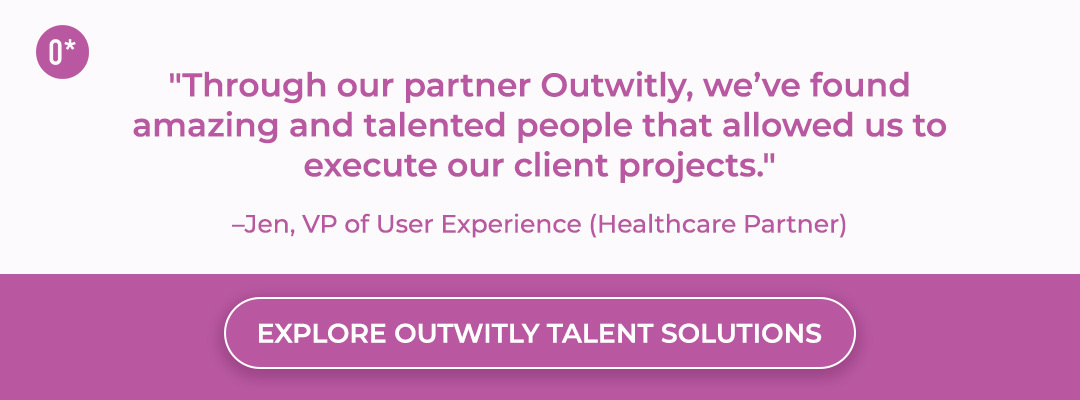
Things are changing fast in the world of design teams! Mass tech layoffs have been on the rise over the past few years, and design and research departments have been majorly affected. Companies are descaling and cutting back on hiring new resources, and design teams feel the pinch. Design directors and leaders of design teams are under pressure – they must continue to motivate their teams while convincing higher-ups that their department is worth keeping around. It’s not an easy spot to be in, that’s for sure.
We’ll say this: Though times are tough, and we can empathize with your stress, there is a light at the end of the tunnel. This blog will provide solutions for motivating your team, making progress on projects with the resources you have left, and building the case for bringing more team members on board during this tricky time.
Let’s get into it!
2024 Landscape of UX Design and Research Layoffs
Over the past few years, stories of skilled professionals negatively impacted by the mass tech layoffs have been all over the news and our LinkedIn feeds. Research shared by TechCrunch says 2023’s tech layoff numbers were counted at over 260,000, up 59% from 2022. In 2024, the turbulence surrounding tech layoffs seems to have subsided, and this year’s recorded layoffs are not reaching the same heights as 2023, but this doesn’t mean we’re in the clear. There are still layoffs happening, and if you’re someone working in a design leadership role, this is probably at the top of your mind.
You’re in a difficult spot as a design director with many UX teams being descaled. You feel called to justify the value of your discipline to executives, trying to prevent your team from the heartwrenching effects of being laid off. You don’t want to worry your team because they need you to lead them through this – they see the news about mass layoffs, too, and they’re nervous about the future. They require your support with their work and day-to-day issues, but at the same time, you’re getting pressure from above with conversations about cutting back and who is next to go.
You’re likely doing all you can to advocate for the value of design to stakeholders. Depending on how mature the organization you work for is (test this using our free UX Maturity Scale downloadable!) and to what extent they value the work of designers and researchers, you probably have to make an additional case for why your team’s work is important. And worst of all, if your team does experience layoffs, you’re still met with the same rate of feature requests, project deadlines, and product releases, with a fraction of the resources you once had.
With the tasks of supporting your team, avoiding potential layoffs, managing the ongoing demands of your projects, and advocating for the value of your work, you have a lot on your plate. 2024 is an exhausting time to be a design leader – we see you, understand your struggle, and want to provide some tips for staying afloat.

How to Motivate UX Designers and Researchers Through Tech Layoffs
When it feels like you have little control over future decisions, you have to take charge of what you can control. How you respond during these difficult times will be key – your team members are probably feeling uncertain about the security of their jobs, and as their leader, they’re looking to you for support. Keeping your team motivated and in good spirits is the top priority!
Here are four tips for boosting team morale during difficult times:
- Mirror Their Feelings: Don’t be afraid to share your feelings while maintaining professionalism. Whether you’re empathizing with employee’s fears or supporting your remaining team members after they’ve lost close friends and colleagues to layoffs, you must lean on your ability to empathize. If your team feels your responses to their struggles are too robotic and impersonal, you risk losing their trust.
- Commit to Maintaining Strong Communication: Foster open and clear communication channels to address employees’ concerns and clarify whatever you can. Let employees know your door (or Zoom room!) is always open. In your communication, be honest but sensitive to what people are experiencing. Remember, not everyone will react the same way – some folks might be upset, and some might remain totally calm. Meet people where they’re at!
- Encourage Comradery: During periods of uncertainty and change, the bonds between team members can serve as a crucial source of strength and resilience! Emphasize the value of collaboration and teamwork in achieving common goals, and set up team-building activities to help folks feel connected.
- Keep them Creatively Inspired: The truth is, everyone in UX, UI or service design is a creative type! So, maintaining a culture that champions innovation and embraces unconventional thinking is important. We suggest incorporating dedicated brainstorming sessions into team meetings and encouraging the exploration of fresh ideas and approaches. Acknowledge and celebrate creative achievements within the team, fostering a supportive atmosphere of recognition and motivation. If you need more inspiration, visit our two-part blog series on Creativity for UX Teams!
Tips for Making Project Progress With Reduced Capacity
When facing a reduction in team capacity due to layoffs or resource reallocation, it’s essential to adapt and prioritize effectively.
Here are a handful of actionable tips to ensure continued progress on your projects:
-
- Prioritize Projects Based on Impact: Break down your project into small, tangible, and manageable pieces, and assign a timeline to each task. With a reduced team size, priorities might shift – you’ll need to assess the importance and urgency of each piece of the project in light of the reduced capacity. Given the available resources, focus on high-impact initiatives that align with strategic objectives and are also feasible. In doing so, you will also continue to showcase the value of UX to stakeholders – especially when they see a direct link to their strategic initiatives and business priorities.
- Monitor Workload: Maintain a regular cadence of meetings to review project statuses and workload distribution among team members. Help prioritize tasks based on deadlines, resource availability, and project dependencies. When your team operates with fewer resources than before but are met with a hefty to-do list, you want to be diligent about tracking workload to prevent burnout. Watch out for signs of burnout and ask your designers frequently how they are doing with the work they have. If your team begins to experience burnout, even in the early stages, make sure to communicate this to your higher-ups – and find ways to mitigate it (such as giving them an afternoon off every now and then or making work hours more flexible).
- Address Project Delays: Put on your project management hat, keep a close eye on project timelines, and identify potential bottlenecks or delays early on. If a project falls behind schedule due to limited capacity, communicate proactively with stakeholders and your leaders. Clearly outline the challenges and propose solutions, such as reallocating resources or adjusting deadlines. Be confident when communicating these delays, for example, “The schedule is being pushed quite far on this project. If you want this to be a priority, we should consider additional resources.”
- Manage Expectations: A common theme amongst the previous two bullet points is the idea of managing expectations. We cannot emphasize the importance of setting realistic expectations with stakeholders and team members enough. Communicate openly about the challenges of reduced capacity and its impact on project timelines and deliverables. Managing expectations upfront can help mitigate misunderstandings and frustrations down the line!
- Consider Hiring Contractors: In situations where additional power is needed to maintain project momentum, consider hiring contractors or freelancers. Temporary staff can provide valuable support during peak work periods, but your organization might need more time to be ready to hire full-time permanent employees again. Be sure to choose your contractors carefully – we recommend working with a specialized staffing solutions company (like us!) to save you time and energy in sourcing the perfect candidates.

Leveraging Contractors in UX Design and Research During Uncertain Times
Hiring contractors can be a strategic solution for maintaining productivity and flexibility in times of uncertainty, such as during economic downturns or periods of organizational transition. There are many reasons your company might want to wait to hire employees, but you can still have the capacity to tackle your projects and meet deadlines if you leverage contractors! Here are a few reasons why staffing contractors is a good immediate solution:
- Immediate Access to Talent: Staffing services can provide immediate access to skilled professionals without the lengthy hiring process associated with full-time employees. This agility allows companies to fill critical roles and address pressing project needs quickly. Plus, hiring contractors saves you a ton of time – if you were to hire full-time, it could take months to source, interview, hire, onboard, and scale the proper talent. There are trials and tests, vetting, background checks, and references associated with hiring full-time, but the same rules don’t apply when it comes to hiring temporary contractors.
- Cost-Effective Solution: Hiring contractors can be more cost-effective than hiring full-time employees, especially considering benefits, payroll taxes, and onboarding expenses. Companies can leverage contractors to fulfill short-term needs (3 to 12 months) without committing to long-term financial obligations associated with permanent hiring.
- Flexibility and Scalability: Contract staffing offers flexibility in scaling (and descaling) resources according to fluctuating project demands. Companies can adjust the size and composition of their workforce as needed without the constraints of permanent employment contracts. While your company likely has a budget for the current year, planning for the future remains to be determined. Consequently, many companies experiencing potential layoffs in 2023/24 are cautious about hiring without a clear view of what lies ahead. Alternatively, hiring contractors allows organizations to meet immediate business needs and avoid issues associated with employee rights, such as severance, legal liabilities, and lengthy onboarding processes. You can then assess your needs again in months to come and decide what’s best. Hello, peace of mind!
- Projects Need to Get Done: The bottom line is there’s still stuff to do – the world keeps turning, and work needs to get done! When resources shift, you’re often left with the same to-do list but fewer people available to help. Leveraging contractors during uncertain times ensures projects stay on track and deadlines are met, allowing seamless execution of project tasks without delay.
- Specialized Expertise: Partnering with a specialized staffing agency like Outwitly provides access to a diverse talent pool with niche skills and expertise quickly. Companies can tap into specialized knowledge and experience in UX design, research, and service design to drive innovation, execute projects efficiently, and achieve strategic objectives.
When pitching the idea of hiring contractors to company decision-makers, it’s essential to articulate a clear and compelling case for this staffing approach. Here’s how to make the pitch effectively:
- Define Clear Roles and Objectives: Clearly outline the scope, role, specialization, timeline, and project objectives for the contractor position. Provide a detailed description of the skills and qualifications required to ensure alignment with project needs.
- Highlight Cost-Benefit Analysis: Present a cost-benefit analysis comparing the expenses of hiring contractors versus full-time employees. Emphasize the potential cost savings, flexibility, and immediate access to talent contractors offer.
- Emphasize Flexibility and Scalability: Stress the importance of flexibility and scalability in responding to dynamic business needs. Position hiring contractors as a strategic solution for adapting to changing market conditions and resource requirements.
- Leverage Outwitly as a Specialized Staffing Partner: If you’re hiring for positions like UX designer, UX researcher, or service designer, partnering with a specialized design and research staffing agency like ours gives you access to top-tier talent in the field. Working with a reputable agency means saving yourself the time it takes to interview, read resumes, and try to interpret whether a candidate has the skills or not – we handle everything.

As you navigate the ever-changing landscape of design teams amidst mass layoffs and economic uncertainty, it’s crucial to remember that there are actionable steps we can take to make things better. Despite the challenges you face as design directors and leaders, there is hope. By prioritizing project tasks, monitoring workloads, addressing delays, managing expectations, and hiring contractors to bridge the gap, we can keep our teams motivated and our projects on track. Remember, you’re not alone in this struggle. Stay resilient, stay inspired, and move forward with determination to help your team succeed.



